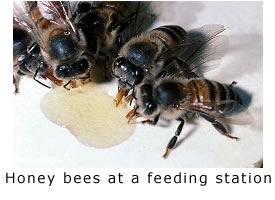Learned Behavior
Learning can be defined as a persistent change in behavior that occurs as a result of experience. Since a newborn nymph or larva has no prior experience, its first behaviors will be entirely innate. Each individual starts life with a “clean slate”: it acquires new skills and knowledge through trial and error, observation of other individuals, or memory of past events. In general, learned behaviors will always be:
- Nonheritable — acquired only through observation or experience
- Extrinsic — absent in animals raised in isolation from others
- Permutable — pattern or sequence may change over time
- Adaptable — capable of modification to suit changing conditions
- Progressive — subject to improvement or refinement through practice
Although insects have relatively simple nervous systems and are not able to master college-level physics, they have demonstrated the ability to “learn” in each of the following ways:
- Habituation is learning to “ignore” stimuli that are unimportant, irrelevant, or repetitive. For example, a puff of air on the cerci of a cockroach will cause the animal to scamper away. But repeating the same stimulus over and over will lead to a decrease in the response and eventually to no response at all. In some insect populations, widespread use of sex pheromone will disrupt mating behavior. By making everything in the world smell like a virgin female, males become habituated to the odor and stop responding to the signal. If a female cannot attract a mate, she will not produce any offspring.
- Classical Conditioning is learning to associate one stimulus with another, unrel
 ated stimulus. Honey bees, for example, learn to associate floral colors and fragrances with the presence of nectar. They can be “trained” to collect sugar water from colored dishes on a feeding table. If a blue dish with pure water sits next to a yellow dish with sugar water, worker bees will quickly learn to associate “yellow” with “food” (even if the dishes are moved around). When solutions in the two dishes are suddenly swapped (sugar to blue and water to yellow), the bees will ignore blue and continue to forage at yellow until they eventually “learn” (by trial and error) to look for the blue dish.
ated stimulus. Honey bees, for example, learn to associate floral colors and fragrances with the presence of nectar. They can be “trained” to collect sugar water from colored dishes on a feeding table. If a blue dish with pure water sits next to a yellow dish with sugar water, worker bees will quickly learn to associate “yellow” with “food” (even if the dishes are moved around). When solutions in the two dishes are suddenly swapped (sugar to blue and water to yellow), the bees will ignore blue and continue to forage at yellow until they eventually “learn” (by trial and error) to look for the blue dish. - Instrumental Learning depends on the animal’s ability to remember the outcome of past events and modify future behavior accordingly. Good consequences (positive feedback) reinforce the behavior and increase its likelihood of occurrence in the future. Bad consequences (negative feedback) have the opposite effect. Cockroaches learning to run through a simple maze to find food is a simple example of instrumental learning (also known as operant conditioning).
- Latent Learning involves memory of patterns or events when there is no apparent reward or punishment associated with the behavior. A sand wasp, for example, learns the location of her nest site by taking a short reconnaissance flight each time she leaves the nest. She remembers the pattern of surrounding landmarks to help her find the nest when she returns. Likewise, worker ants can remember a series of landmarks along a trail and follow them (in reverse order) back home to the nest site. Honey bees also show latent learning when they follow the waggle dance of a forager and then use that information to find the reported nectar source.
- Imprinting is a special case of programmed learning that occurs early in life and only within a short time-window known as the “critical period”. During this brief interval, the animal acquires an indelible memory of certain salient stimuli in its “home” environment (taste of the host plant, smell of the nest site, etc.). This memory is retained throughout life and recalled later when needed. Fruit fly larvae, for example, will imprint on the taste and smell of their food. If reared on a diet that contains apple extract, adult females will show a strong preference for apples when they eventually search for a place to lay their own eggs. Not just any stimulus will do. Imprinting is apparently regulated by an innate “neural template” that restricts what can be remembered.

